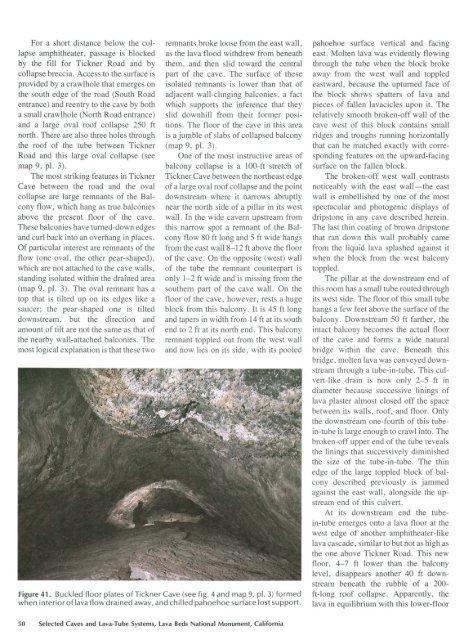Lava cascade in Thunderbolt Distributary of Labyrinth Cave system
report
report
You also want an ePaper? Increase the reach of your titles
YUMPU automatically turns print PDFs into web optimized ePapers that Google loves.
For a short distance below the collapse<br />
amphitheater, passage is blocked<br />
by the fill for Tickner Road and by<br />
collapse breccia. Access to the surface is<br />
provided by a crawlhole that emerges on<br />
the south edge <strong>of</strong> the road (South Road<br />
entrance) and reentry to the cave by both<br />
a small crawlhole (North Road entrance)<br />
and a large oval ro<strong>of</strong> collapse 250 ft<br />
north. There are also three holes through<br />
the ro<strong>of</strong> <strong>of</strong> the tube between Tickner<br />
Road and this large oval collapse (see<br />
map 9, pl. 3).<br />
The most strik<strong>in</strong>g features <strong>in</strong> Tickner<br />
<strong>Cave</strong> between the road and the oval<br />
collapse are large remnants <strong>of</strong> the Balcony<br />
flow, which hang as true balconies<br />
above the present floor <strong>of</strong> the cave.<br />
These balconies have turned-down edges<br />
and curl back <strong>in</strong>to an overhang <strong>in</strong> places.<br />
Of particular <strong>in</strong>terest are remnants <strong>of</strong> the<br />
flow (one oval, the other pear-shaped),<br />
which are not attached to the cave walls,<br />
stand<strong>in</strong>g isolated with<strong>in</strong> the dra<strong>in</strong>ed area<br />
(map 9, pl. 3). The oval remnant has a<br />
top that is tilted up on its edges like a<br />
saucer; the pear-shaped one is tilted<br />
downstream, but the direction and<br />
amount <strong>of</strong> tilt are not the same as that <strong>of</strong><br />
the nearby wall-attached balconies. The<br />
most logical explanation is that these two<br />
remnants broke loose from the east wall,<br />
as the lava flood withdrew from beneath<br />
them, and then slid toward the central<br />
part <strong>of</strong> the cave. The surface <strong>of</strong> these<br />
isolated remnants is lower than that <strong>of</strong><br />
adjacent wall-cl<strong>in</strong>g<strong>in</strong>g balconies, a fact<br />
which supports the <strong>in</strong>ference that they<br />
slid downhill from their former positions.<br />
The floor <strong>of</strong> the cave <strong>in</strong> this area<br />
is a jumble <strong>of</strong> slabs <strong>of</strong> collapsed balcony<br />
(map 9, pl. 3).<br />
One <strong>of</strong> the most <strong>in</strong>structive areas <strong>of</strong><br />
balcony collapse is a 100-ft stretch <strong>of</strong><br />
Tickner <strong>Cave</strong> between the northeast edge<br />
<strong>of</strong> a large oval ro<strong>of</strong> collapse and the po<strong>in</strong>t<br />
downstream where it narrows abruptly<br />
near the north side <strong>of</strong> a pillar <strong>in</strong> its west<br />
wall. In the wide cavern upstream from<br />
this narrow spot a remnant <strong>of</strong> the Balcony<br />
flow 80 ft long and 5 ft wide hangs<br />
from the east wall 8-12 ft above the floor<br />
<strong>of</strong> the cave. On the opposite (west) wall<br />
<strong>of</strong> the tube the remnant counterpart is<br />
only 1-2 ft wide and is miss<strong>in</strong>g from the<br />
southern part <strong>of</strong> the cave wall. On the<br />
floor <strong>of</strong> the cave, however, rests a huge<br />
block from this balcony. It is 45 ft long<br />
and tapers <strong>in</strong> width from 14 ft at its south<br />
end to 2 ft at its north end. This balcony<br />
remnant toppled out from the west wall<br />
and now lies on its side, with its pooled<br />
Figure 41. Buckled floor plates <strong>of</strong> Tickner <strong>Cave</strong> (see fig. 4 and map 9, pl. 3) formed<br />
when <strong>in</strong>terior <strong>of</strong> lava flow dra<strong>in</strong>ed away, and chilled pahoehoe surface lost support.<br />
pahoehoe surface vertical and fac<strong>in</strong>g<br />
east. Molten lava was evidently flow<strong>in</strong>g<br />
through the tube when the block broke<br />
away from the west wall and toppled<br />
eastward, because the upturned face <strong>of</strong><br />
the block shows spatters <strong>of</strong> lava and<br />
pieces <strong>of</strong> fallen lavacicles upon it. The<br />
relatively smooth broken-<strong>of</strong>f wall <strong>of</strong> the<br />
cave west <strong>of</strong> this block conta<strong>in</strong>s small<br />
ridges and troughs runn<strong>in</strong>g horizontally<br />
that can be matched exactly with correspond<strong>in</strong>g<br />
features on the upward-fac<strong>in</strong>g<br />
surface on the fallen block.<br />
The broken-<strong>of</strong>f west wall contrasts<br />
noticeably with the east wall-the east<br />
wall is embellished by one <strong>of</strong> the most<br />
spectacular and photogenic displays <strong>of</strong><br />
dripstone <strong>in</strong> any cave described here<strong>in</strong>.<br />
The last th<strong>in</strong> coat<strong>in</strong>g <strong>of</strong> brown dripstone<br />
that ran down this wall probably came<br />
from the liquid lava splashed aga<strong>in</strong>st it<br />
when the block from the west balcony<br />
toppled.<br />
The pillar at the downstream end <strong>of</strong><br />
this room has a small tube routed through<br />
its west side. The floor <strong>of</strong> this small tube<br />
hangs a few feet above the surface <strong>of</strong> the<br />
balcony. Downstream 50 ft farther, the<br />
<strong>in</strong>tact balcony becomes the actual floor<br />
<strong>of</strong> the cave and forms a wide natural<br />
bridge with<strong>in</strong> the cave. Beneath this<br />
bridge, molten lava was conveyed downstream<br />
through a tube-<strong>in</strong>-tube. This culvert-like<br />
dra<strong>in</strong> is now only 2-5 ft <strong>in</strong><br />
diameter because successive l<strong>in</strong><strong>in</strong>gs <strong>of</strong><br />
lava plaster almost closed <strong>of</strong>f the space<br />
between its walls, ro<strong>of</strong>, and floor. Only<br />
the downstream one-fourth <strong>of</strong> this tube<strong>in</strong>-tube<br />
is large enough to crawl <strong>in</strong>to. The<br />
broken-<strong>of</strong>f upper end <strong>of</strong> the tube reveals<br />
the l<strong>in</strong><strong>in</strong>gs that successively dim<strong>in</strong>ished<br />
the size <strong>of</strong> the tube-<strong>in</strong>-tube. The th<strong>in</strong><br />
edge <strong>of</strong> the large toppled block <strong>of</strong> balcony<br />
described previously is jammed<br />
aga<strong>in</strong>st the east wall, alongside the upstream<br />
end <strong>of</strong> this culvert.<br />
At its downstream end the tube<strong>in</strong>-tube<br />
emerges onto a lava floor at the<br />
west edge <strong>of</strong> another amphitheater-like<br />
lava <strong>cascade</strong>, similar to but not as high as<br />
the one above Tickner Road. This new<br />
floor, 4-7 ft lower than the balcony<br />
level, disappears another 40 ft downstream<br />
beneath the rubble <strong>of</strong> a 200-<br />
ft-long ro<strong>of</strong> collapse. Apparently, the<br />
lava <strong>in</strong> equilibrium with this lower-floor<br />
50 Selected <strong>Cave</strong>s and <strong>Lava</strong>-Tube Systems, <strong>Lava</strong> Beds National Monument, California















